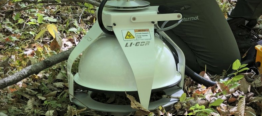(单词翻译:单击)
听力文本
Even the dirt on the ground is likely making climate change worse, a new study finds. Researchers have shown that warmer temperatures are heating the soil, which is causing microbes to become more active and release more of the soil's carbon into the atmosphere.
Ben Bond-Lamberty of the Joint Global Change Research Institute is the lead author of the study. He says, These soil changes can potentially contribute to even higher temperatures.
The findings were published on August 2 in the journal Nature.

Scientists studied device readings, soil measurements, plant growth details and satellite observations from around the world. Their work is the most complete study yet on the subject.
They found a sharp increase in carbon released into the atmosphere by bacteria and fungi in soil from 1990 through 2014. Researchers explain that the carbon comes from the dead plants and leaves the microbes eat. As temperatures rise, the microbes eat more. And the more they eat, the more carbon they make into carbon dioxide and release into the atmosphere.
This uncontrolled cycle speeds up and intensifies climate change, says Jerry Melillo of Marine Biological Laboratory in Massachusetts. Melilo was not part of the study.
Overall, soil releases about nine times more carbon than human-caused activities. But that is part of a natural cycle: The amount of carbon released into the air is about equal to the carbon oceans and plants take in.
However, carbon released from fossil fuel causes an imbalance. Burning coal, oil and natural gas puts more carbon into the atmosphere than nature can take out. The additional carbon heats the air and soil. And as the air and soil get hotter, the earth will release yet more carbon that it has been holding.
If something isn't done, we are really in trouble, said Rattan Lal of Ohio State University, who wasn't part of the study.
He added that proper soil conservation can help keep more carbon in soil. Conservation methods include avoiding turning the soil, covering off-season crops and leaving crop deposits on the ground.
I'm Alice Bryant.
重点解析
1.come from 来自
He's just come from the countryside.
他刚从乡下来。
2.speed up 加速
The truck speeded up after it left town.
卡车在离开城镇之后加速。
参考译文
即便是土地上的泥土也会让气候变化加剧,这是一项新研究的发现。研究人员发现,气候变暖会使土壤温度升高,继而引起微生物活跃度升高,将土壤释放到大气中的碳量升高。
全球变化联合研究所的本 邦德(Ben Bond-Lamberty)是该研究的第一作者。他表示,土壤的这些变化很可能会导致气候变暖加剧。
他们的发现发表在了8月2日的《自然》期刊上。
科学家读取了设备的数据,测量了土壤,了解了植物的生长细节情况,并观测了全球各地的卫星。他们的研究是该主题下最为完整的一个。
他们发现土壤中细菌和真菌释放到大气中的碳在1990-2014年间有了快速的增长。对此,研究人员的解释是:微生物食用了死去的植物和树叶,然后释放出了碳。随着气温的升高,微生物的食用量也会加大。微生物食用量越大,就为二氧化碳的生成提供了更多碳,继而导致大气中二氧化碳升高。
这个循环过程不受控制,随着该过程的加速,气候变化也开始加速,马萨诸塞州海洋生物实验室的杰里 梅利洛(Jerry Melillo)如是说道。梅利洛并未参与此次研究。
总体来看,土壤释放的碳是人类活动的近9倍。但这是某自然循环的部分过程:释放到大气中的碳量与海洋和植物吸收的量几乎相等。
不过,化石燃料释放出的碳也会导致失衡。燃烧煤、石油、天然气释放出的碳要大于自然的吸收量。多出来的碳会导致空气和土壤升温。随着空气和土壤温度的升高,地球上排放的碳就超过了它的承受力。
如果什么都不做,我们就有麻烦了,俄亥俄州立大学的拉坦 拉尔(Rattan Lal)如是说道。拉坦也没有参与此项研究。
拉坦补充道,土壤保持可以将碳更多地保留在土壤中。保护的方法包括但不限于:尽量不翻土,淡季时覆盖庄稼,保留庄稼的残留物。
爱丽丝 布赖恩特(Alice Bryant)您播报。
译文为可可英语翻译,未经授权请勿转载!


